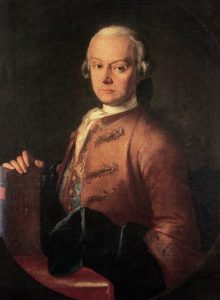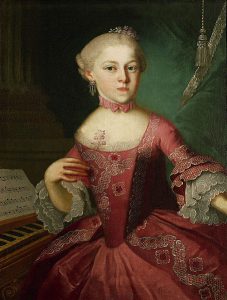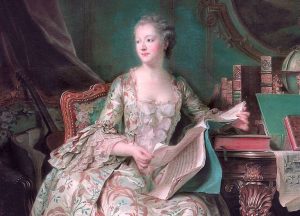
On November 18, 1763, 256 years ago today, the Mozart family – father Leopold, mother Anna Maria, daughter Marianne (12 years old) and son Wolfgang (7 years old) – arrived in Paris. They were in the midst of their “Grand Journey”, a 3½ year concert tour of Central and Western Europe that was to change the history of Western music.
I would suggest that few peacetime activities are more harrowing and exhausting than concert tours. The endless travel wreaks havoc on the human body; the cookie-cutter hotels, restaurants, airports and airport lounges wreak havoc on the human psyche; the schlepping and rehearsing and having to summon the energy to treat every audience as if it were the only audience wreaks havoc on the human soul. And yet to make a living, musicians must perform, and that means they must tour. In doing so, they leave their wives, husbands, children, friends, and homes behind – and in the process anything approaching normalcy and routine – for the untamed wilderness of the road.
I’m burning out just thinking about it.
Some tours go on for months, and some go on for years. Between 2002 and 2005, Cher’s “Living Proof: The Farewell Tour” played 326 concerts, was attended by 3.5 million people and grossed $250 million (that’s $329 million in 2019 dollars). Between 2014 and 2017, “The Garth Brooks World Tour with Trisha Yearwood” played 366 concerts, was attended by 4.7 million people and grossed $364 million.
(In terms of sheer attendance, the Ed Sheeran “÷ [‘Divide’] Tour” attracted 8.787 million live attendees over the course of its 255 shows between 2017 and 2019. In terms of sheer gross $, the present champion is the “U2 360° Tour”, which generated $820 million in 2019 dollars in 110 shows. Nearly a billion dollars. That’s a lot of money.)
However: the great-grandmother of all of these tours, the one that put the phrase “concert tour” into our modern lexicon, was the tour taken by the Mozart family between June 9, 1763 and November 30, 1766, a tour that has come to be known as “The Grand Journey”.

On November 21, 1747, the 28-year-old Leopold Mozart – a musician from Augsburg (in today’s Germany) presently living in Vienna – married Anna Maria Pertl. The couple had seven children, though only two of them survived their infancy. The first was Maria Anna Walburga Ignatia, known as Marianne and nicknamed Nannerl; she was born on July 30 or 31, 1751. 4½ years later, a son was born on January 27, 1756 and named Johannes Christian Wolfgang Gottlieb Mozart.

When she was 7 and her baby brother Wolfgang 3, Marianne began keyboard (harpsichord) lessons with her father. Almost immediately the young Wolfgang began to imitate his sister, initially, perhaps, to earn his share of attention from his father, Leopold. However, it quickly became apparent that this was no ordinary three-year-old boy banging upside a harpsichord. Leopold began giving Wolfgang lessons as well, and his progress was nothing short of astonishing. By four the child could learn to play fairly long pieces in a half an hour’s time; a few weeks after his fifth birthday he had written his first compositions; by six he had taught himself to play the violin well enough to participate in the playing of trios and quartets with adults. According to eyewitnesses, Wolfgang’s passion for music was so all-encompassing that he was interested in nothing else; even children’s games had to have some sort of musical component if he was to participate in them.
How did Leopold Mozart react to his son’s prodigious talent and promise? No surprise: he was astounded and overjoyed, and he immediately took over every facet of his son’s education, both musical and non-musical.
Leopold Mozart had no intention of keeping his little gold mine under wraps for very long. In January of 1761, when Wolfie was 5, the Mozart family traveled to Munich for three weeks, where the 5-year-old Wolfgang played for and astonished, among others, the elector of Bavaria, Maximilian III. This trip paved the way for a much longer and more ambitious trip the following fall, a three-month visit to Vienna.
It was with this Viennese visit that Mozart’s rise to fame began. Leopold wrote home:
“Everyone is amazed at the boy, and everyone whom I have heard says that his genius is incomprehensible.”
The Viennese court did more than applaud: they showered the Mozarts with money; two weeks into the trip Leopold had managed to bank 120 ducats, more than two years of his salary at Salzburg. But it was also during this stay in Vienna that Leopold revealed something quite ugly about himself. When Wolfgang fell ill with scarlet fever on October 21 and could not perform until November 4, Leopold fumed in a letter: “This [illness] has cost me fifty ducats at least!!!”
On returning home to Salzburg the Mozart family were greeted like conquering heroes. Leopold and his wife Anna Maria immediately began planning an extended tour of Europe.
Which brings us to the Grand Journey, the if-it’s-Monday-it-must-be-Mantua; if-it’s-Tuesday-it-must-be-Trenton; if-it’s-Wednesday-it-must-be-Waco tour: the tour that made the Mozart legend, the tour that spawned stories and myths we’re still sorting through more than 250 years later, the tour that made Mozart the child prodigy by which we measure prodigies to this day.

On June 9, 1763, the Mozart family – Leopold, Anna Maria, Marianne and Wolfgang – left Salzburg. They would be away for three years, five months, and twenty days. They stopped and performed in 88 different towns and cities. I offer for your pleasure a partial list of these burgs, in the order in which they were visited:
Munich, Augsburg, Ludwigsburg, Schwetzingen, Heidelberg, Mainz, Frankfurt, Koblenz, Poppelsdorf, Falkenlust, Bonn, Cologne, Brussels, Paris, Versailles, Calais, Dover, London (where they stayed for over 15 months!), Bourne Place, Dunkirk, Lille, Ghent, the Hague (den Haag), Amsterdam, Utrecht, Rotterdam, Antwerp, Dijon, Lyon, Geneva, Lausanne, Bern, Zurich, Winterthur, Schaffhausen, Donaueschingen, Ulm.
Talk about your frequent four-horse-coach miles.

By the time the family arrived back in Salzburg on November 30, 1766, they had performed for tens-of-thousands of people. In a pre-electronic age, when the only way to actually hear someone play was to see him in concert, Wolfgang Mozart had indeed been seen and heard by a vast percentage of Europe’s musical cognoscenti.
Writes Mozart biographer Maynard Solomon:
“Leopold Mozart left home a musician of good, even noteworthy reputation; by the time the family returned to Salzburg he was a figure of great renown. He and his children had written a new chapter in the history of music and were celebrated throughout Europe beyond all expectation. For decades thereafter, those who had witnessed Mozart’s performances recalled them as astonishing feats of virtuosity. As late as 1830, Goethe still spoke of having heard Mozart, vividly remembering ‘the little man with his wig and his sword.’ The image of the child Mozart had permanently entered the folklore of Western civilization.”
As the Mozarts’ trip progressed, unbelievable stories of prodigious musicality preceded them, only to be confirmed once they had arrived in a city and performed there. They were a sensation, a travelling musical circus, instant celebrities wherever they went.

Having arrived in Paris 256 years ago today, Leopold’s first job was to finagle an invitation to the royal court at Versailles. This took a bit of time; the Mozart family arrived at Versailles on Christmas Eve for what turned out to be a two week stay. The principal mover-and-shaker at the court of King Louis XV was Jeanne Antoinette Poisson, Marquise of Pompadour, best known as Madame de Pompadour. She has been Louis XV’s “official chief mistress” from 1745 to 1751, and in 1763 she was still a most influential person. According to Mozart’s sister Nannerl:
“She [Madame de Pompadour] had Wolfgang placed on the table in front of her but refused to allow him to kiss her when he bent forward to do so, prompting him to ask indignantly, ‘Who is this woman who won’t kiss me? Even the Empress [Maria Theresa] kissed me!’”
The Mozart kids had fewer problems with King Louis XV’s many daughters. According to Leopold, the princesses not only allowed the Mozart children “to kiss their hands, but kissed them innumerable times [in return].” On New Year’s Eve, “Wolfgang was graciously privileged to stand beside the Queen the whole time, to talk constantly to her, entertain her and kiss her hands repeatedly, besides partaking of the dishes which she handed him from the table.”
The hospitality at Versailles was great (the Mozart children were showered with expensive gifts), but it paled in comparison to the reception the family received when it arrived in London in April of 1764, 10 months into the tour. From the King and Queen to the general public, London audiences adored the Mozarts, particularly little Wolfgang. A typical announcement for a London performance reads as follows:
“Miss Mozart of eleven and Master Mozart of seven Years of Age, Prodigies of Nature; taking the opportunity of representing to the Public [Master Mozart], the greatest Prodigy that Europe or that Human Nature has to boast of. Everybody will be astonished to hear a Child of such tender Age playing the Harpsichord in such a Perfection – it surmounts all Fantastic and Imagination, and it is hard to express which is more astonishing, his Execution upon the Harpsichord playing at Sight, or his own Composition.”
The family earned money in London almost faster than Leopold could count it. Leopold reported from London, “At the courts up to the present we have been received with extraordinary courtesy. But the welcome that we have been given here exceeds all others.”
By the time The Grand Journey ended, it had become clear to Leopold Mozart that his ticket to fame and fortune would be his son, Wolfgang. We are witness, then, to a troubling reversal of the usual financial roles, as a child – a small, sensitive, desperate-to-please child – became the main bread-winner for his father, mother and sister. As long as Wolfgang remained young and small and pliant, his magical and continually developing talents would both fascinate the public and satisfy Leopold’s monetary and social needs. But, as the father of four children myself, hard experience has taught me that no one stays young and pliant forever, particularly not someone who was petted and kissed by empresses and princesses at a formative age.
But on November 18, 1763 – 256 years ago today – Wolfgang’s battles with his father were still far in the future. For now, let us imagine a crisp November day and the sense of awe and promise the Mozart family must have felt when arriving in Paris, which was – and remains – one of the world’s very greatest cities.
For lots more on Mozart’s life and times I would direct your attention to my Great Masters biography of Mozart, published by The Great Courses and available for examination and download at RobertGreenbergMusic.com. I’d also invite you to join me on Patreon for even more on Mozart and many others.
Listen on the Music History Monday Podcast
Podcast: Play in new window
Subscribe: Apple Podcasts | Spotify | Pandora | iHeartRadio | RSS | More
